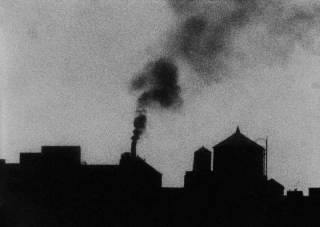Like Seeing New York for the First Time 1
Date: 15 April 2001 | Season: Century City
LIKE SEEING NEW YORK FOR THE FIRST TIME
Sunday 15 April 2001, at 3pm
London Tate Modern
LIKE SEEING NEW YORK FOR THE FIRST TIME: 1
Six Extraordinary Films of Manhattan in the 60s & 70s
Two programmes of films selected by Mark Webber for the Tate Modern exhibition “Century City: Art and Culture in the Modern Metropolis” (1 February – 29 April 2001), presenting six unique views of New York in the 60s and 70s.
NEW YORK PORTRAIT: CHAPTER 1
Peter Hutton, USA, 1978-79, b/w, silent, 16 min
Hutton’s black and white haikus are an exquisite distillation of the cinematic eye. The limitations imposed – no colour, no sound, no movement (except from a vehicle not directly propelled by the filmmaker), no direct cuts since the images are born and die in black – ironically entail an ultimate freedom of the imagination. If pleasure can disturb, Hutton’s ploys emerge in full focus. These materialising then evaporating images don’t ignite, but conjure strains of fleeting panoramas of detached bemusement. More than mere photography, Hutton’s contained-within-the-frame juxtapositions are filmic explorations of the benign and the tragic. (Warren Sonbert)
Hutton’s most impressive work, the filmmaker’s style takes on an assertive edge that marks his maturity. The landscape has a majesty that serves to reflect the meditative interiority of the artist independent of any human presence. New York is framed in the dark nights of a lonely winter. The pulse of street life finds no role in New York Portrait; the dense metropolitan population and imposing urban locale disappear before Hutton’s concern for the primal force of a universal presence. With an eye for the ordinary, Hutton can point his camera toward the clouds finding flocks of birds, or turn back to the simple objects around his apartment struggling to elicit a personal intuition from their presence. Hutton finds a harmonious, if at times melancholy, rapport with the natural elements that retain their grace in spite of the city’s artificial environment. The city becomes a ghost town that the filmmaker transforms into a vehicle reflecting his personal mood. The last shot looks across a Brooklyn beach toward the skyline of Coney Island’s amusement park. The quiet park evokes the once frantic city smothered by winter. Nature continues its eternal cycles impervious to the presence of man, the aspirations of society, or the decay of the metropolis. (Leger Grindon, Millennium Film Journal, 1979)
STILL
Ernie Gehr, USA, 1969-71, colour, sound, 53 min
In Still, Gehr’s picture of place feels most like home. From the perspective of a ground-floor window, we look out at a bit of Lexington Avenue just south of 31st Street in Manhattan, the one-way traffic and the people going by, crossing the street, entering and leaving a luncheonette – nothing out of the ordinary – except for the superimpositions, the ghostly presences, of other people, other cars and buses and trucks inhabiting the same place. These are not supernatural but material ghosts, conjured without mystification or fuss by double exposures done in the camera. And yet this technique works wondrously to evoke the mysterious interplay of different times in the life of a place, times of the day and of the year, pieces of personal and social history that have here come to pass. This is a film about place in time, and in time we sense that this is a place happily haunted by its ghosts. One admirer, the dramatist Richard Foreman, called Still an intimation of paradise. It is paradise found in the yellow of cabs and the green of a tree across the street, in the way that things are seen to fit, body and ghost, into the fabric of the world. It is paradise found in the kind of detachment that is most deeply involving. Still begins in silence and in winter. The tree is bare, the light is low, and the wintry white of a parked car stands at the centre of the screen. Then suddenly the tree is in bloom and the light is bright, the long shadows of winter are gone and the sounds of the city are heard. Wintry white gives way to the double-exposed spring yellow of two superimposed pairs of parked taxicabs. If the fluorescent-lit interior of an institutional corridor is “an unlikely vantage point to view the dawn,” as Sitney remarks in his book on Gehr, “a stretch of Lexington Avenue in the 30s is almost as unlikely a spot to hail the coming of spring.” But we work with what we’ve got, and from the view out the window Gehr composes an urban salute to spring as stirring as any bucolic one. (Gilberto Perez, Yale Review, October 1999)
REAL ITALIAN PIZZA
David Rimmer, Canada, 1971, colour, sound, 10 min
Taken between September 1970 and May 1971, with the unmoving camera apparently bolted to the window ledge, this film, a ten-minute eternity, chronicles what takes place within view of the lens. The backdrop is a typical New York pizza stand, the actors are selected New Yorkers who happened to be there during the half year, the plot is the somewhat sinister aimlessness of life itself. (Donald Ritchie, Museum of Modern Art, New York)
David Rimmer has quietly placed his camera in the blind spot everyone walks past. A fire engine, lights flashing, stops for the firemen to dash in to get some pizza to take to the fire … You haven’t been to New York ’til you’ve seen Real Italian Pizza. (Gerry Gilbert, BC Monthly)
